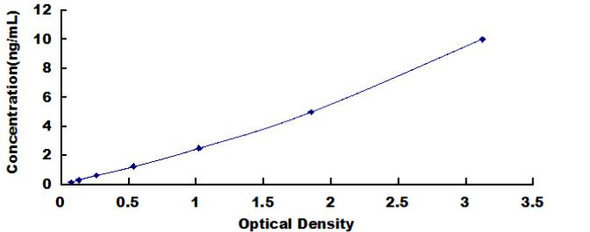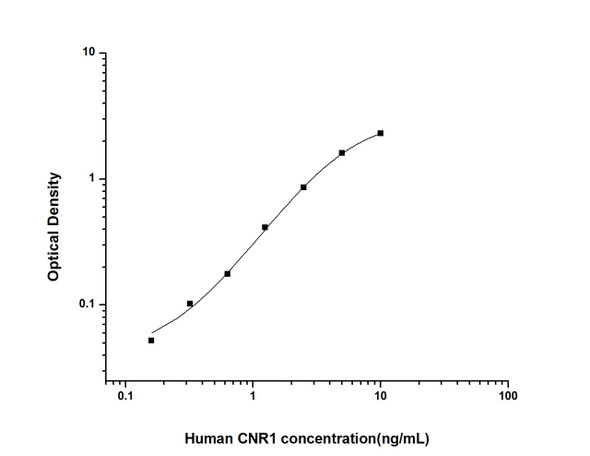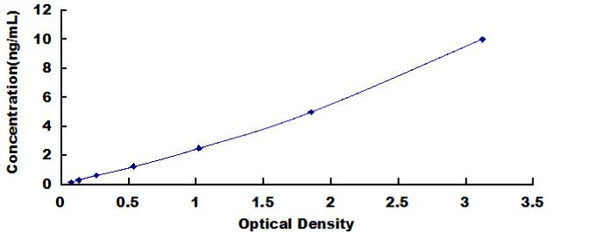Human Cell Biology ELISA Kits 3
Human CNR1 (Cannabinoid Receptor 1, Brain) CLIA Kit (HUES00420)
- SKU:
- HUES00420
- Product Type:
- ELISA Kit
- ELISA Type:
- CLIA Kit
- Size:
- 96 Assays
- Sensitivity:
- 18.75pg/mL
- Range:
- 31.25-2000pg/mL
- ELISA Type:
- Sandwich
- Reactivity:
- Human
- Sample Type:
- Serum, plasma and other biological fluids
- Research Area:
- Cell Biology
Description
| Assay type: | Sandwich |
| Format: | 96T |
| Assay time: | 4.5h |
| Reactivity: | Human |
| Detection method: | Chemiluminescence |
| Detection range: | 31.25-2000 pg/mL |
| Sensitivity: | 18.75 pg/mL |
| Sample volume: | 100µL |
| Sample type: | Serum, plasma and other biological fluids |
| Repeatability: | CV < 15% |
| Specificity: | This kit recognizes Human CNR1 in samples. No significant cross-reactivity or interference between Human CNR1 and analogues was observed. |
This kit uses Sandwich-CLIA as the method. The micro CLIA plate provided in this kit has been pre-coated with an antibody specific to Human CNR1. Standards or samples are added to the appropriate micro CLIA plate wells and combined with the specific antibody. Then a biotinylated detection antibody specific for Human CNR1 and Avidin-Horseradish Peroxidase (HRP) conjugate are added to each micro plate well successively and incubated. Free components are washed away. The substrate solution is added to each well. Only those wells that contain Human CNR1, biotinylated detection antibody and Avidin-HRP conjugate will appear fluorescence. The Relative light unit (RLU) value is measured spectrophotometrically by the Chemiluminescence immunoassay analyzer. The RLU value is positively associated with the concentration of Human CNR1. The concentration of Human CNR1 in the samples can be calculated by comparing the RLU of the samples to the standard curve.
| UniProt Protein Function: | CNR1: Involved in cannabinoid-induced CNS effects. Acts by inhibiting adenylate cyclase. Could be a receptor for anandamide. Inhibits L-type Ca(2+) channel current. Isoform 2 and isoform 3 have altered ligand binding. Belongs to the G-protein coupled receptor 1 family. 3 isoforms of the human protein are produced by alternative splicing. |
| UniProt Protein Details: | Protein type:GPCR, family 1; Membrane protein, integral; Receptor, GPCR; Membrane protein, multi-pass Chromosomal Location of Human Ortholog: 6q14-q15 Cellular Component: growth cone; intracellular membrane-bound organelle; integral to plasma membrane; axon; plasma membrane Molecular Function:cannabinoid receptor activity; drug binding Biological Process: response to nicotine; negative regulation of mast cell activation; maternal process involved in pregnancy; negative regulation of fatty acid beta-oxidation; regulation of synaptic transmission, glutamatergic; negative regulation of nitric-oxide synthase activity; positive regulation of apoptosis; axonal fasciculation; response to morphine; positive regulation of acute inflammatory response to antigenic stimulus; response to lipopolysaccharide; negative regulation of action potential; sensory perception of pain; glucose homeostasis; response to cocaine; regulation of synaptic transmission, GABAergic; memory; G-protein signaling, coupled to cAMP nucleotide second messenger; G-protein signaling, coupled to cyclic nucleotide second messenger; response to ethanol; positive regulation of fever; spermatogenesis; negative regulation of blood pressure; negative regulation of dopamine secretion; regulation of insulin secretion; response to nutrient; positive regulation of blood pressure; aging |
| NCBI Summary: | This gene encodes one of two cannabinoid receptors. The cannabinoids, principally delta-9-tetrahydrocannabinol and synthetic analogs, are psychoactive ingredients of marijuana. The cannabinoid receptors are members of the guanine-nucleotide-binding protein (G-protein) coupled receptor family, which inhibit adenylate cyclase activity in a dose-dependent, stereoselective and pertussis toxin-sensitive manner. The two receptors have been found to be involved in the cannabinoid-induced CNS effects (including alterations in mood and cognition) experienced by users of marijuana. Multiple transcript variants encoding two different protein isoforms have been described for this gene. [provided by RefSeq, May 2009] |
| UniProt Code: | P21554 |
| NCBI GenInfo Identifier: | 115562 |
| NCBI Gene ID: | 1268 |
| NCBI Accession: | P21554. 1 |
| UniProt Secondary Accession: | P21554,Q13949, Q495Z0, Q4PLI4, Q4VBM6, Q5JVL5, Q5UB37 Q9UNN0, B2R9T4, E1P512, |
| UniProt Related Accession: | P21554 |
| Molecular Weight: | Observed MW: 53kDaCalculated MW: 45kDa/49kDa/52kDa |
| NCBI Full Name: | Cannabinoid receptor 1 |
| NCBI Synonym Full Names: | cannabinoid receptor 1 (brain) |
| NCBI Official Symbol: | CNR1 |
| NCBI Official Synonym Symbols: | CB1; CNR; CB-R; CB1A; CB1R; CANN6; CB1K5 |
| NCBI Protein Information: | cannabinoid receptor 1; central cannabinoid receptor |
| UniProt Protein Name: | Cannabinoid receptor 1 |
| UniProt Synonym Protein Names: | CANN6 |
| Protein Family: | Cannabinoid receptor |
| UniProt Gene Name: | CNR1 |
| UniProt Entry Name: | CNR1_HUMAN |
As the RLU values of the standard curve may vary according to the conditions of the actual assay performance (e. g. operator, pipetting technique, washing technique or temperature effects), the operator should establish a standard curve for each test. Typical standard curve and data is provided below for reference only.
| Concentration (pg/mL) | RLU | Average | Corrected |
| 2000 | 55708 55734 | 55721 | 55693 |
| 1000 | 23690 24258 | 23974 | 23946 |
| 500 | 11696 10368 | 11032 | 11004 |
| 250 | 4941 5647 | 5294 | 5266 |
| 125 | 2710 2506 | 2608 | 2580 |
| 62.5 | 1348 1274 | 1311 | 1283 |
| 31.25 | 646 702 | 674 | 646 |
| 0 | 27 29 | 28 | -- |
Precision
Intra-assay Precision (Precision within an assay): 3 samples with low, mid range and high level Human CNR1 were tested 20 times on one plate, respectively.
Inter-assay Precision (Precision between assays): 3 samples with low, mid range and high level Human CNR1 were tested on 3 different plates, 20 replicates in each plate.
| Intra-assay Precision | Inter-assay Precision | |||||
| Sample | 1 | 2 | 3 | 1 | 2 | 3 |
| n | 20 | 20 | 20 | 20 | 20 | 20 |
| Mean (pg/mL) | 101.58 | 241.95 | 857.53 | 92.17 | 236.52 | 805.01 |
| Standard deviation | 10.49 | 26.40 | 77.26 | 8.23 | 28.22 | 65.61 |
| C V (%) | 10.33 | 10.91 | 9.01 | 8.93 | 11.93 | 8.15 |
Recovery
The recovery of Human CNR1 spiked at three different levels in samples throughout the range of the assay was evaluated in various matrices.
| Sample Type | Range (%) | Average Recovery (%) |
| Serum (n=5) | 93-107 | 99 |
| EDTA plasma (n=5) | 93-106 | 99 |
| Cell culture media (n=5) | 97-113 | 105 |
Linearity
Samples were spiked with high concentrations of Human CNR1 and diluted with Reference Standard & Sample Diluent to produce samples with values within the range of the assay.
| Serum (n=5) | EDTA plasma (n=5) | Cell culture media (n=5) | ||
| 1:2 | Range (%) | 92-106 | 88-104 | 102-119 |
| Average (%) | 98 | 95 | 109 | |
| 1:4 | Range (%) | 87-98 | 100-119 | 94-105 |
| Average (%) | 92 | 108 | 100 | |
| 1:8 | Range (%) | 94-108 | 97-114 | 98-115 |
| Average (%) | 99 | 104 | 106 | |
| 1:16 | Range (%) | 99-114 | 92-106 | 90-101 |
| Average (%) | 105 | 97 | 96 |
An unopened kit can be stored at 4°C for 1 month. If the kit is not used within 1 month, store the items separately according to the following conditions once the kit is received.
| Item | Specifications | Storage |
| Micro CLIA Plate(Dismountable) | 8 wells ×12 strips | -20°C, 6 months |
| Reference Standard | 2 vials | |
| Concentrated Biotinylated Detection Ab (100×) | 1 vial, 120 µL | |
| Concentrated HRP Conjugate (100×) | 1 vial, 120 µL | -20°C(shading light), 6 months |
| Reference Standard & Sample Diluent | 1 vial, 20 mL | 4°C, 6 months |
| Biotinylated Detection Ab Diluent | 1 vial, 14 mL | |
| HRP Conjugate Diluent | 1 vial, 14 mL | |
| Concentrated Wash Buffer (25×) | 1 vial, 30 mL | |
| Substrate Reagent A | 1 vial, 5 mL | 4°C (shading light) |
| Substrate Reagent B | 1 vial, 5 mL | 4°C (shading light) |
| Plate Sealer | 5 pieces | |
| Product Description | 1 copy | |
| Certificate of Analysis | 1 copy |
- Set standard, test sample and control (zero) wells on the pre-coated plate and record theirpositions. It is recommended to measure each standard and sample in duplicate. Note: addall solutions to the bottom of the plate wells while avoiding contact with the well walls. Ensuresolutions do not foam when adding to the wells.
- Aliquot 100µl of standard solutions into the standard wells.
- Add 100µl of Sample / Standard dilution buffer into the control (zero) well.
- Add 100µl of properly diluted sample (serum, plasma, tissue homogenates and otherbiological fluids. ) into test sample wells.
- Cover the plate with the sealer provided in the kit and incubate for 90 min at 37°C.
- Aspirate the liquid from each well, do not wash. Immediately add 100µL of BiotinylatedDetection Ab working solution to each well. Cover the plate with a plate seal and gently mix. Incubate for 1 hour at 37°C.
- Aspirate or decant the solution from the plate and add 350µL of wash buffer to each welland incubate for 1-2 minutes at room temperature. Aspirate the solution from each well andclap the plate on absorbent filter paper to dry. Repeat this process 3 times. Note: a microplatewasher can be used in this step and other wash steps.
- Add 100µL of HRP Conjugate working solution to each well. Cover with a plate seal andincubate for 30 min at 37°C.
- Aspirate or decant the solution from each well. Repeat the wash process for five times asconducted in step 7.
- Add 100µL of Substrate mixture solution to each well. Cover with a new plate seal andincubate for no more than 5 min at 37°C. Protect the plate from light.
- Determine the RLU value of each well immediately.






